Every year the marketing age of broilers decreases by an average of 0.75 days for the same performance. This trend is likely to continue in the same direction for the coming years. Nutrition plays a vital role in enabling this improvement. As the feed cost represents an expensive input (~70-80% of broiler production cost), the poultry producer should be aware of the dynamics of the feed in its influence on final product quantity and quality.
Formulating feed ideally requires in-depth knowledge of several parameters such as the energy level to be maintained in the diet, balancing the amino acid profile and electrolytes of feed etc., which, otherwise, if not properly monitored, could negatively influence the performance and profitability of the business.
Further, in light of environmental challenges and disease outbreaks, it is even more challenging to extract the total genetic capability of the birds.
Nutritionists should look at several critical parameters whilst formulating broiler feed. Important amongst these are:
1. Nutritive value of raw materials
2. Amino acid digestibility
3. Amino acid and calorie ratio
4. Selection of suitable fat source
5. Calcium requirement of birds
6. Electrolyte balancing
7. Immuno-modulation
8. Summer management
1. Nutritive value of raw materials
Raw materials are purchased based on price, availability and nutritive value. Nutritive value of raw materials varies from time-to-time, source-to-source and batch-to- batch.
It is a very important task to assess the nutritive value each time to ensure that the feed being manufactured is of desired quality.
It is essential to have preset quality parameters for each and every raw material, based on which purchase of raw material should be made.
Upon purchase of raw material it needs to be analysed for quality parameters after collecting a representative sample. The ideal quality parameters for some key raw materials are as mentioned
Soya de-oiled cake
·Bulk Density: 570-640 g/1000 cc
·Desired Physical Properties
- Colour - Light tan to light brown
- Odour - Fresh, not musty, not sour or burned
- Texture - Homogeneous, free flowing, no lumps or cakes, without coarse particles or dusty
·Urease activity: 0.05-0.20-pH unit change
·Moisture (max): 12%
·Protein solubility (0.2% KOH): 73-85%
·Protein Dispersibility Index: 15-30%
·Contaminants: Particularly check for urea, non-protein nitrogen and/or ammonia
·Crude Protein (min.): 44.0%
·Fiber (max.): 7.0%
·Ash (max.): 6.0%
·Silica (max.): 1.0%
·ME (kcal/kg): ~ 2,375
Fish / Fish meal
·Moisture (max.): 10.0%
·Sand and silica (max.): 5.0%
·Salt (max.): 3.0%
·Urea: Nil
·Check for Decomposition / Rancidity
·Contamination with leather meal
·Bacterial load
·Crude Protein (varies depending on the variety of the fish)
·Ether extract (varies depending on the variety of the fish)
Maize
·Moisture (max.): 12.0%
·Check for Aflatoxins
·Thiram
·Grain size
Amino acid digestibility
In general, an average of 90% digestibility is considered whilst formulating feeds or feed formulations are based on total amino acids only. Since the raw materials vary in digestibility, it is necessary to consider digestible amino acids whilst formulating the feed to ensure optimum performance.
From Table 1, it is clear that formulations based on digestible amino acids will deliver better results as in many cases the actual digestibility is much lower than the assumed level of 90%.
Further, feed formulations made by using digestible amino acids will economise feed cost for equal performance.
3. Amino acid and calorie ratio
Environmental temperature and the energy content of the feed are key determinants for the feed intake of the bird. Other nutrients are normally adjusted based on the feed intake of the bird. There exists a relationship between energy and digestible amino acids, which if maintained, will enable adjustment of crude protein levels in the diet, thereby reducing the feed cost without compromising performance.
Optimum live performance, maximum protein retention and reduced carcass fat content can only be obtained if a proper ratio between energy and digestible amino acids is maintained. However these ratios vary between different growing periods, i.e. Starter, Grower and Finisher.



Nutritionists employ different energy levels ranging from 2800 to 3300 kcal/kg of feed whilst formulating broiler feeds. As energy increases it is imperative to increase the digestible lysine content.
The energy amino acid ratio as depicted in Table 2 has been found helpful in extracting the maximum genetic capacity of broilers in the Indian context.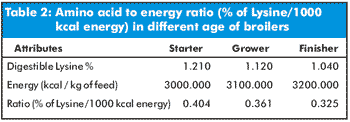
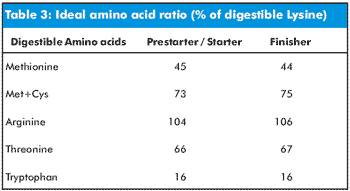
In order to arrive at an ideal amino acid profile, the other critical amino acids need to be balanced with reference to lysine (Table 3) after maintaining the energy and digestible lysine ratio
4. Animal Fat/ Vegetable Fat
Fat from animal source as well as from vegetable source are used in feeds. An ideal fatty acid profile should be maintained in the diet to improve the keeping quality and meat quality. Ideal ratios of unsaturated and saturated fatty acids ensure the desired fatty acid profile and ultimately better results.
As a general guideline the ratio between unsaturated and saturated fatty acids should be 'more than one' for better meat quality.
Depending on the following factors, the poultry feed manufacturer should select the fat source to be included in poultry feed:
·Fatty Acid Composition
·Availability
·Quality
·Metabolizable energy content
·Price
Some points regarding fat usage in diet are as follow
·Crude Oils are preferred in poultry over refined oils
·Vegetable source is preferred over animal source
·The essential fatty acids for poultry are Linoleic acid and Linolenic acid, based on which, fat source may be decided
·The oil should be procured fresh
·An Antioxidant should be used for the oil source to avoid rancidity
Some fats and their fatty acid composition are given in Table 4 and energy provided by them in Table 5.
Feed grade fats and oils usually contain water and other non-fat materials; adjustments in fatty acid and ME concentrations should be made accordingly. ME level of diet is subjected to variation depending on level of fat inclusion in diet, ingredient composition and age of poultry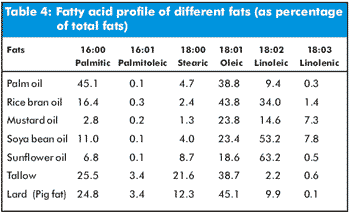

5. Calcium requirement of birds
Next to energy, birds adjust their feed intake based on calcium requirement. In other words, birds will eat more feed for want of calcium-a phenomenon also referred to as calcium hunger. The rapid growth of broilers requires large quantities of feed to be consumed and hence feed manufacturers maintain the calcium level at a marginal level.
In addition to Calcite / Marble powder and DCP, raw materials used in the feed also supply calcium to the birds. It is common to utilise the published values of calcium levels of raw materials during formulating feeds. However, like other nutrients, the calcium content of raw materials varies widely.
Excess calcium will bind to phosphorus (2 molecules of calcium will bind to one molecule of phosphorus) and make phosphorus unavailable to birds, which is a costly input to the feed manufacturers. Further, majority of the feed additives used in the poultry feed are based on a calcium carbonate carrier, which also contributes significant amount of calcium to the diet.
Keeping this in sight, an assessment of calcium in the raw materials and final feed has to be performed:
·Estimation of calcium in the raw materials like Maize, SoyaDOC, Fish/Fish meal, MBM
·Calculation of calcium content in the feed additives
·Estimation of calcium in DCP, Calcite / Marble powder
·Estimation of calcium in the final feeds
Understanding the calcium content of feeds and manipulating it to improve production dynamics is important towards enhancing productivity.
6. Electrolyte balancing
Electrolyte balance is represented by Na+K-Cl balance in the diet. Electrolyte balance is expressed in terms of mEq.
Balancing of electrolytes in the poultry feed is essential in order to spare the bird from utilizing energy in attempting to do the same in metabolizing the feed. Apart from salts such as Sodium Chloride, Sodium Bi-carbonate and Potassium Chloride etc., Electrolytes (Sodium, Potassium and Chloride) are also derived from feed raw materials.
Electrolytes are further derived from feed additives like Chloride from Lysine Hydrochloride, Choline Chloride etc. An assessment and adjustment in the electrolytes balance is important whilst formulating feeds.
Electrolyte balance (Na+K-Cl) of poultry feed should be maintained between 200 to 250 mEq per kg of feed
7. Immuno-modulation
The current trend of intensive poultry keeping and omnipresent disease threats require specific attention towards improving the immune status of the bird through nutrition.
A number of dietary components can have direct and / or indirect implication on the intensity and efficacy of the immune responses. Some are capable of increasing the immune responses while others are detrimental to it. There is no doubt that broilers on well balanced diet sare immunologically competent and able to cope up better with disease challenges.
It is imperative that most nutrients necessary for optimal growth (energy, amino acids, etc.) are also necessary for optimal immuno-competence. The following factors have to be looked into for improving immunity through nutrition:
·A well-balanced feed with adequate energy and amino acid profile
·Proper dietary arginine concentration
·Proper sodium and chloride levels
·Levels of vitamin A, E and C
·Optimum Methionine level
·Adequate Zinc, Manganese and Copper level
Apart from these, various natural and synthetic additives are available to improve immunity.
Summer management
Feed formulation requires significant adjustment during summer season. The reduction in feed intake and thus reduction in specific dynamic heat of metabolism improves the tolerance of birds towards hot weather. Moreover, changes in the macro and micro formulation increase the passage time of nutrients in the intestine. Some points to be considered during summer management are:
·Increase in the energy content of the feed is required to take care of the reduction in the feed intake in spite of the fact that in summer, the maintenance energy requirement for the bird is comparatively less. The increase in energy is best achieved by adding fat (oil) that stimulates feed intake and further improves the palatability of feed. Fat also reduces the rate of passage of ingesta within the digestive system. (At the same time we need to reduce daily intake of energy by the bird)
·Proportional increase in other nutrients, proportionate to the increase in the energy level
·Minimising the excess of amino acids improves feed intake
·A diet with lower protein levels and supplemented with limiting amino acids will help in reducing stress to the kidney and also lowering of ammonia levels in poultry houses
·Ammonium chloride supplementation through feed improves weight gain.
·Sodium bicarbonate addition in diet is beneficial
·Micro minerals may be over the normal requirement .
·Inclusion of potassium .5 kg / chloride 0.5 kg / MT feed in prestarter and starter diets is also useful
·Feed electrolyte balance should be maintained more than 250 mEq especially in the summer. (The bicarbonate ions coming from sodium bicarbonate should also be considered while balancing)
·Usage of Vitamin C (coated) at a minimum dose of 100g / MT of feed is advisable
·Chelated trace minerals usage is advisable
· Increase in the fibre content of the feed is useful in slowing down the intestinal motility (which is normally higher in the summer). Including at least 2- 3% SFDOC to increase the fibre in all types of feed will deliver better results. (This will contribute at least 0.3 to 0.4% increases in the fibre of the diet)
· Inclusion of enzymes is preferable during summer months
· Addition of Phytase (80 to 200 g/ton) depending on the feed formula is useful in reducing the stress to the birds
Micro nutrient optimisation
Various micro ingredients are employed in poultry feed production in terms of additives / supplements to make up the deficiency (vitamins, trace minerals etc.,) to maximise the performance (Antibiotic growth promoters, Lysophospholipids etc.) or to combat disease challenges (Anticoccidials, Antibiotics etc.). An ideal combination of micro ingredients will depend upon the type of raw materials used in the feed, environmental challenges and the growth pressure.
Optimizing the micro ingredient formulation with right level of additives is important in maximising the genetic potential of the bird.
Modifying the growth response curve
At a given feed formulation, broilers respond to one particular growth curve. Nutritionist optimizes the growth pattern towards a desired growth curve B (as shown in figure1) to maximise the economics of broiler production.
For the given formulation, observations of the growth curve will help in determining the duration of each feed to be given to the bird. Ideally the prestarter or starter feed (Protein rich feed) should be given to develop the body frame rather than developing body mass.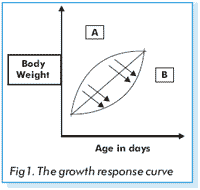
Further, the developing focus of poultry business is towards functional parameters and other specific tasks such as:
- High breast meat yield
- Reduced abdominal fat
- Improved texture and taste of the meat
- Raising without antibiotics
- Rearing broilers without lameness
Nutritionists at Avitech recom-mend the following nutritional standards for broilers to extract the genetic potential of broilers (Table 6).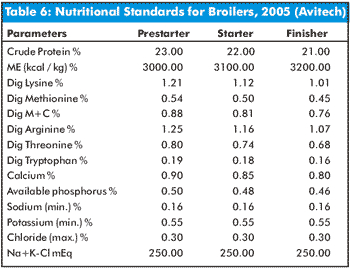



ساحة النقاش